Ricordi di Torricella
Memories of Torricella
| The
Letter [1] |
|
|
|
Ricordi di Torricella
Memories of Torricella
| The
Letter [1] |
|
|
WHY DID OUR PEASANTS NEED TO KNOW HOW TO READ AND WRITE? In practice, anyone born and raised in Torricella knew all its inhabitants; in this they were aided by: - nicknames which distinguished all the families; - many activities and amusements that they all carried out together. Such occasions, amongst other things, constituted times for meeting up with each other and for exchanging information. There was the customary manner, moreover, in which people addressed each other prefaced in increasing order of respect by the title of “Zi” (Uncle), “Za” (Aunt),” “Mastr” (Master or Sir) and “Don” (Godfather) and rarely “Vossignori” (Lord). Also everyone knew everybody else’s business since the community was small and traditionally they all participated in everyone’s joy and grief. The community communicated verbally and, if they wanted to let all the people know about some news, the Parish Priest would talk about it at the Sunday mass; for secular matters instead there was the town-crier who, going from street to street, attracted attention with a long blast on his trumpet and then repeated the news that everyone needed to know. Immediately everyone exchanged their points of view, interpretations and criticisms of the news they had heard. All jobs were learned in silence, by watching and by trying to copy how they were done. In reality, knowing how to read and write was considered to be something prestigious, but of little use; especially since everyone, from their earliest childhood, had learned how to read the big book of nature, which was available to all and as sincere and uncontaminated as was the pure fresh-air that everyone could breathe in those days. This state of equilibrium was broken when various personalities, presuming directly to call themselves the upholders of divine rights, began to give orders that absolutely had to be carried out. To do this the orders had to be written down so as to be undisputable and, moreover, because of the large number of illiterates, it was immediately written into the written orders that being unable to read did not constitute an excuse for citizens not to respect the public orders. The self-styled upholders of divine rights always wrote directly to the men, because on a certain day they had to leave all their present and future commitments to be at the disposition of these same people who put themselves in charge, day and night in places far distant places in Italy or abroad, even at the cost of dying or returning mutilated, since in turn they were charged with wounding and killing other men. Their families, wives, children, fields, animals, were all things which ought not to interest those who were doing God’s will, except in that these could be appropriated, without any compensation (or damages) and without any explanation, if that was convenient for some others of the self-styled upholders of divine rights. What is more, these people in charge provided extremely severe penalties for those who did not behave as they were supposed to do, according to the appropriate written orders, which the recipient could not even read. These people in charge, always giving nothing in return, demanded in writing, with unquestionable orders, irresistible threats, and without any argument, payment in cash of a “tax”, commensurate with the capacity of this stolen land to provide an income. In spite of the French Revolution, the Restoration, the Constitution of the States and the Unification of Italy, such offences and robberies, carried out for many years to the harm of our poor peasants, continued for many more years, to such an extent as to force many of them to flee: to emigrate abroad. But emigrating to far off countries meant cutting the ties to their own world and the one week link that could continue to exist was just the epistolary relationship (letters). A population with a high level of illiteracy, with the “good luck” of a unified Italy, suddenly had to learn not only to read and write, but in the Piedmontese-Tuscan Roman language (unfamiliar to many) because this was convenient for the self-styled upholders of divine rights of the time. It is needless to say that in their frequent conversations, our peasants displayed a real hatred towards all those self-styled upholders of divine rights; after the fall of the Bourbons, it was not by chance that in our native zone there arose many brigands in much the same way as that attributed to the legendary Robin Hood. “L’ se fa la lettera” “Do you know how to read and write?” was the terrible question that still circulated in Torricella when I loved there, since there were documents to be read, sent by some pushy upstart, or else when people were thinking about the possibility of emigrating. With bureaucratic times that had nothing to do with economic resources or technical updates, finally the Italian State became aware that all Italians needed to be able to read and write; so they built and equipped very many schools in… Libya (??); they are still there but not even the Libyans use them. With residual resources left over from empire building, even villages like Torricella laboriously set up elementary schools, only for them to be destroyed immediately after by the War, so greatly disliked by the poor people but so highly desired by the self-styled upholders of divine rights, for reasons such as racism and greed to possess things belonging to others. At this point one must ask oneself whether the people in charge had misunderstood things or whether, when God gave his orders to these self-styled upholders of divine rights, he forgot about his own COMMANDMENTS. |
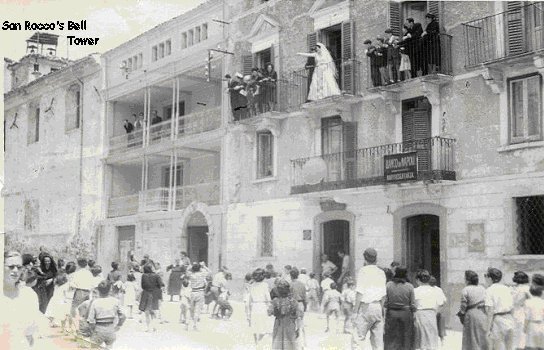 Figure 1 in this photo of a wedding, one can clearly see the small bell tower of the Church of San Rocco |
| As the month of October approached in 1946, everyone in Torricella was talking about the reopening of the school, the buildings of which had been destroyed in the War due to German mines; the fascist culture was driven out by the democrats’ victory, but whilst many teachers were amongst the fascists in flight, there were also many teachers amongst the partisans who were following them (and as we know they followed all the way to Bologna). | ||
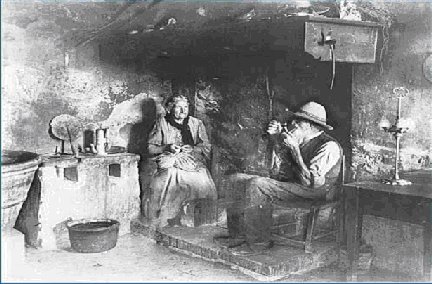 Figure 2 in the aftermath of War people’s needs grew ever more serious |
||
|
|
||
|
|
||
|
Many of our peasants thought that since they had to work day and night in their
own land, they would be able to work much better in a country where people only
worked eight hours a day and did not work at all on Saturdays or Sundays. Nobody warned them of the trap. No-one told them that in those countries everyone works for themselves and at a rhythm (pace) of work that the peasants could never even have imagined; everyone had to think of themselves and there would be problems if you ever had the misfortune to need help from others. |
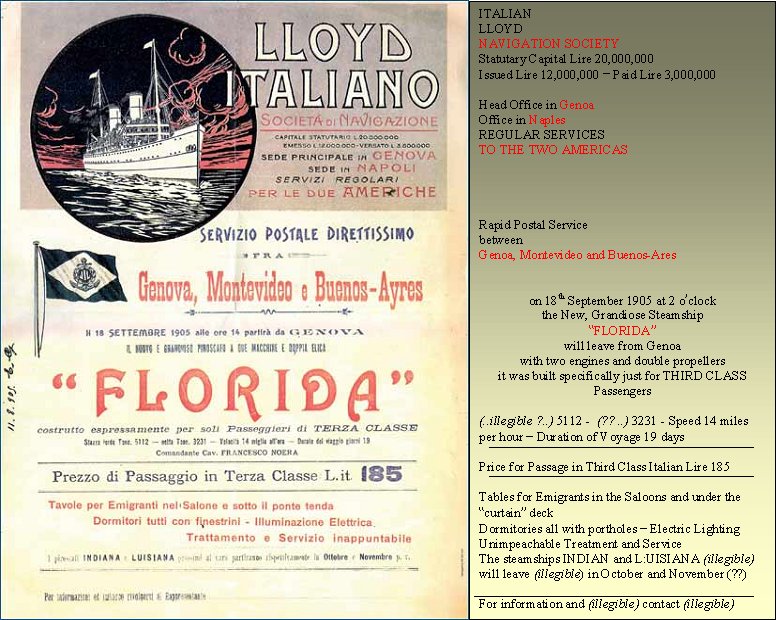 Figure 5 alluring invitations to leave one’s own land |
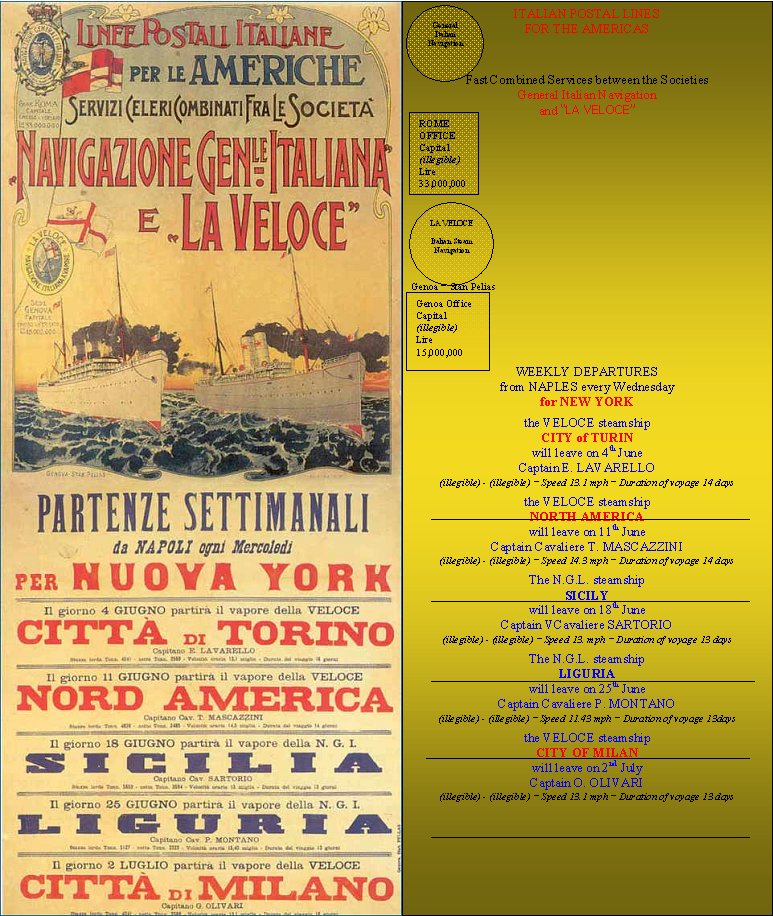 Figure 6 ease of escaping poverty |
 Figure 7 there were many large families of peasants; of all ages; each individual had work duties to carry out |
|
Poverty, infinitely worsened by the War, persuaded an ever greater number of
people of the need to emigrate and thus, in spite of everything, everyone worked
together to set up again the mechanism that would allow as many citizens as
possible to be able to reply positively to the question “l se fa la lettera?”
On the 15th of October 1946, at 8:30 am, the small bell in the bell tower of the Church of San Rocco was “tolled” very fast to announce the start of lessons, which for me were those of the second elementary class. Our classroom had been set up on the second floor on the north-west side of the old Town Hall building restores as well as could be for the occasion. |
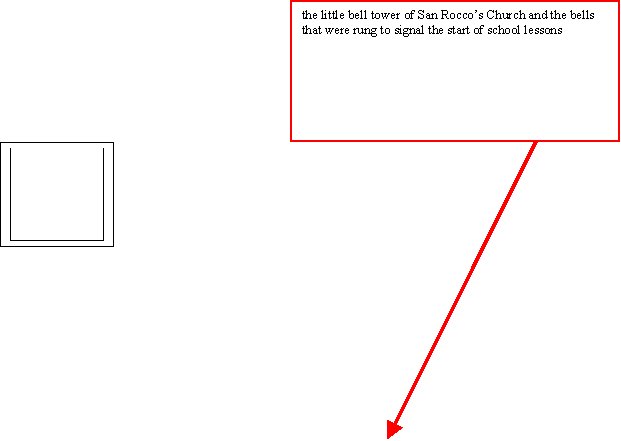
|
|
“Zi Ricuccie” was the official sacristan (sexton) of the Church of San Giacomo
and as such he was also the keeper of the heavy keys of the Church of San Rocco,
dilapidated in parts not having been rebuilt after the War. The keys gave access
to the dangerous wooden staircase that led to the small bell tower of the church
of San Rocco. To ring those bells was a trusted duty for it was highly risky and a full “peel” could not be rung because as they swung they might collapse together with the small bell tower. They were rung as a “toll” one at a time; by means of a leather handle you caught the clapper which struck the inside of the bell; its sound, with a silvery tone, could clearly be heard by all the inhabitants of Torricella and it was rung with the greatest punctuality. “Zi Ricuccie” was a particularly unforgettable personality; of medium height and of very thin build (in those days there were very few fat people but he exceeded in the opposite sense); he dressed in grey or black with a professional “style” suit of his time, but you couldn’t help noticing that the suit was full of mends and darns, repairs, adjustments, washing and ironing that it had undergone in the last 30 years; the suit was complete with a waistcoat that also was worn out but which he still kept with pride, a pride in the waistcoat pocket with a large chain; there was also a breast pocket for keeping his small glasses for short-sightedness in those rare moments when he wasn’t wearing them on his nose. He was never without his cap and he was always in a bad mood although somewhat lessened by his tendency to talk little. “Zi Ricuccie” lived in the third building on the right on the Road that climbs from the Church of San Giacomo towards the “piane” (the district known as The Plains); I lived with my grandparents in the fourth building on the same street; I spent a lot of time watching what “Zi Ricuccie” did; I was tolerated by him because he did everything in silence and, despite my nature, I had understood that with him I must not speak and especially not ask any questions; maybe it was due to this attitude that at first he tolerated me and later on became my friend and trusted me. He had many children some grown up and I recall two very nice youths, two young girls about eighteen years old, one of whom was called Teresa and a girl of about my age who was called Genoveffa. His wife, always dressed in black, rather fat, constantly grumbling, was called “Za Annina”. “Zi Ricuccie” carried out the duties of caretaker (janitor) at the school; “Zi Ricuccie” also served meals to the solitary prisoner in Torricella’s Prison; the prison was located by climbing the staircase at the corner that leads to the “tirriete” (the district known as the terraces[5]). “Zi Ricuccie” was also known as “lu stagnine” (the tinman) because amongst the many little jobs that he did he was also a tinsmith; everything on a small scale; maybe due to his limited strength; I’ve seen him transform an empty food tin (perhaps collected from the rubbish) into an oil or petrol lamp with the same elegance as an antique lamp; I’ve watched him making brooms and brushes and other similar things, using Broomcorn[6] (Sorghum) as the raw material. I’ve also seen him carry out small repairs and maintenance of various pieces of equipment from the Church of which he was the Sacristan. All in all I thought he was nice, even if his suit and his bad temper might have been a mirror image of the suit and temper of Don Cosma, who was the crabby, despotic Parish Priest of “Zi Ricuccie” during the period in which I lived in Torricella. The first time “Zi Ricuccie” placed his trust in me was when he first gave me the burdensome task of going to ring the bell for the start of lessons, up the dangerous little bell tower of the old Church of San Rocco. Later he even authorised me to take with me a person that I myself trusted. In practice I was the person announcing the start of lessons; this operation was made easier by the fact that in front of the Church of San Rocco you could easily see the clock on the bell tower of the Church of San Giacomo. Anyone who has never rung a bell (I mean one pulled by hand, not the electronic type in use today) cannot know what a joy and atavistic pleasure it gives, especially for a child; also I was courted by my companions who all wanted to be the one chosen to accompany me and go and ring the bell for the start of lessons. |
|
|
|
THE CLASSROOM |
||
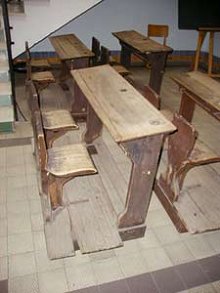 Figure 10 desks and furniture fixed up after the War |
|
Figure 12 desks and furniture fixed up after the War |
|
|
||
|
Also because the Second Elementary was attended by over thirty children whose
ages ranged from 7 to 14 years; thus there were not only the problems of the
various different sizes, shapes and capabilities of each scholar, but also the
fact that children were not considered to be people, but rather as “things” that
were a burden and a nuisance. MY FRIENDS AT SCHOOL |
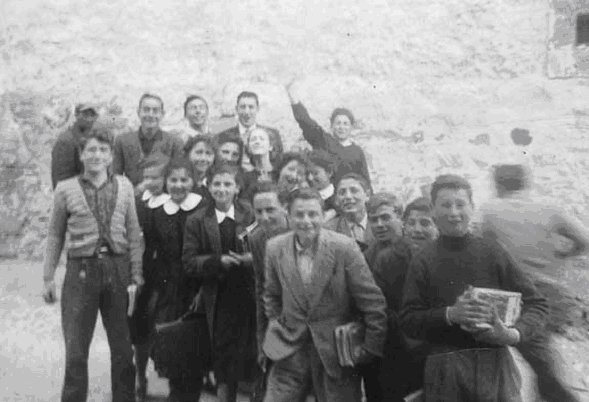 Figure 14 from Silvio Porreca’s album, 1946. |
|
Very few of them are recognisable: the first standing on the left, in the
foreground, with a pale cardigan, is Domenicuccio di fiorenze; next to him, the
first two girls in the front are Luisella Pellicciotta (the daughter of Teresa
di capè) and Gabriella Teti de la sciabbilette; in front, in a pale jacket and
carrying books under his arm is Giuseppe Vitacolonna di ribbecche; next to him,
in a dark sweater is Silvano Fedele. I am not in that photo and it probably wasn’t of the Second Elementary Class. In my class, however, there was a boy called Francesco or De Francesco, whose father, a partisan, had been killed by the Germans. There was also a Porreca, the same age as me, and he was the son of Torricella’s Pharmacist. |
||
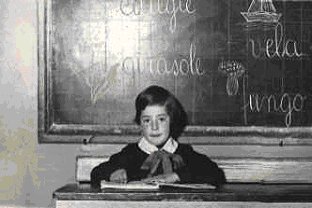 |
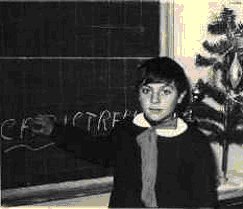 |
 |
|
Figure 15 the radiators behind the little girl did not work, but played a
part in the fascist “scenery” (note the wood-burning-stove in the first photo of this School section, Figure 9) |
||
|
|
|
|
Why so much difference? Because it was the first year that the school had
reopened after the break for the War. Children who had become six years old in
1940, 1941, 1942, 1943, 1944 and 1945 had not been able to start going to
school; on the other hand, many of the parents had been happy enough to avoid
making them waste time with the excuse of going to school. Instead of working in
the fields, the children were busy with their schooling (getting there, studying
and sometimes living at the school). Since that type of school delivered things equally to people with widely differing needs, there was a very high percentage of failure; especially amongst those who could not speak the Piedmontese-Tuscan language that was used by the teachers, to preserve their own caste, rather like the mumbo-jumbo “latinorum” of Manzoni[8]. (In Manzoni’s novel, the young man complains about the mumbo-jumbo in Latin, used by the priest, which the hero calls “latinorum”). The conditioning was such that many children persuaded themselves that they were mentally handicapped and thus not fit to go to school. Of all the public institutions, however, the School was the only one which was granted a minimum of consideration, since, in lucky cases, the young people did learn how to read and write letters and then they were able to communicate with their own families during the long periods of obligatory military service[9] or in cases where they had emigrated; everything else that the school did was a big waste of time that led them to neglect their agricultural and pastoral duties, from which instead they were able to obtain concrete results. The other public institutions were considered to be hostile or openly adversarial, which was damaging to the peasants and to their work. The State demanded, first and foremost, payment in cash of “taxes” (imposed commensurate with the ownership of funds beginning with their productivity); in a society in which ready cash was almost non-existent, it truly was a torture to try to gather together the necessary sum. The State took the young men at the peal of their energies and used them “under the yoke” “al giogo[9]” of servitude, for the game of war in the rivalry between their other reigning relatives in other States; in many cases the youths never came back whilst others were seriously mutilated. They were not allowed to grow tobacco but were compelled to buy the low quality stuff that was sold at very high prices by the State itself. I don’t recall the names of those scholars but you could easily tell their social standing by the language they spoke, from their clothes, from the extreme fear and reverence in which they held the teacher and obviously from their poor scholastic progress. Their callused hands were not very dexterous and thus poorly able to hold the pencils, rubbers, pens, pen and ink; their books and exercise books were typically “dog-eared”. Of about 35 pupils who attended the Second Elementary Class, there were about ten or twelve who always got everything wrong and so were destined to be whipped by Master Verna. I truly mean “whipped”, since the teacher knew that he might hurt himself if he gave them a slap or used his fist. For this purpose he always had ready a horse-whip, which before Register, or the books, or any other thing in the mornings, he would carry into the classroom and he used it more than anything else in his teaching. His method was not that which had been used for thousands of years to tame wild animals, that is the use of “a carrot and a stick”; he had further modified this method into “insults and whippings”. From the heights of his “culture” he had even convinced the parents that those “beasts” should only be treated in this manner. His whip and his use of it had become normal, peaceful teaching aids. Especially for those young people whose parents were unable to put forward any arguments against such educational methods.
THE TEACHER |
 Figure 18 horse whip (the main educational tool of Maestro Verna) |
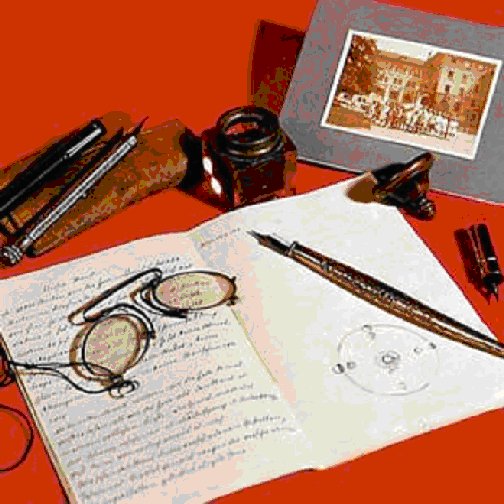 Figure 19 Other professional tool for writing with pens and pen and ink |
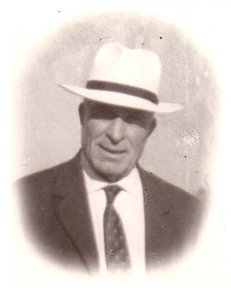 Figure 20 Podestà from 1936 to 1944 - Giovanni Verna, elementary school teacher, Member of the National Fascist Party[11] |
| I do not believe that he carried out his studies in Rome in the 1700’s where he could only have learned from some old edict written in stone like the following: |
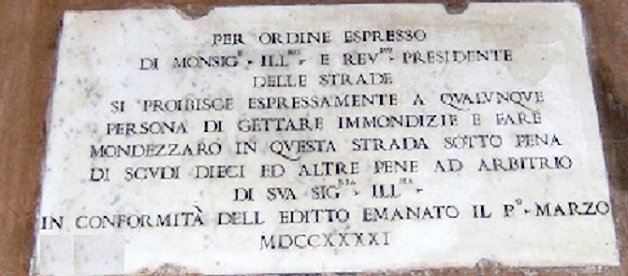 Figure 21 Rome Via dei Pettinari (about halfway along on the left going towards the Tiber |
 Figure 21a TRANSLATION OF FIG 21 |
|
Of Public Whippings. Even when amusing themselves, the Romans needed to be careful; as to severity (if not otherwise threatened) the authorities did not joke about it. Perpetrators of carnivalesque “excesses” risked corporal punishment. Flogging, for example, or “tratti di corda”[12]. In this case the unlucky victim was pulled up from the ground via a pulley by a rope attached to his arms, tied behind his back, and then suddenly let to fall. And nothing about it was fake (or pretence). IN Rome at that time, the instruments for this torture were spread along the most frequented roads of the city. In 1692 “a man wearing a Punch (Pulcinella) mask was whipped around the city because he had been joking (lewdly) in the Corso with a salame”. This is just one example from the many in the “News” in those days. It may be that the population was not worried by this any more. Torture, like imprisonment, was considered almost as a sort of “natural disaster”. Even prostitutes, if discovered wearing a mask – which was a forbidden thing for them to do – were whipped, obviously in public, and needless to say, along the Corso…. everything is a spectacle! If whipping was a beneficial entertainment imagine what the mindful teacher would have thought about a serious activity such as schooling. I am convinced that he too, as a child, would have been the victim of oppression by the previous generation, which he passed on for over forty years to the children of Torricella. How was generation oppression born and passed on The mathematical proof that Galileo Galilee[13] presented in 1613 to convalidate Copernicus’s hypothesis, according to which the Earth rotated around the Sun and not vice-versa, was defined as “false and absurd” by the Roman Catholic Church. In 1616 Galileo was forced to recant and ended his days under house arrest; he went blind (in 1638 and died in 1642). It was not until over three hundred years later that finally the Church decided to remedy its error and remove Galileo’s writings from the “index”, allowing them freedom of circulation. Today we all find ourselves in an analogous situation to that in which the Church found itself in Galileo’s day; but the difference is that the game-play is much higher, in that our decision as to truth or error will have greater consequences for the survival of humanity, than those of the seventeenth century had. For some years, it has been scientifically proven (even though it is still forbidden to act on it) that the pernicious consequences of traumas in childhood inevitably have repercussions on Society as a whole. This discovery affects every single person and if people were properly informed, there would be a substantial change in our Society and especially it would free us from the blind spiral of violence. In the section that follows I shall try better to clarify my thoughts: 1) Every child enters the world to grow, develop, live, love and express their own needs and feelings, with the aim of better safeguarding their own person. 2) In order to develop harmoniously, the child needs to receive attention and protection by adults who take the child seriously, love him and help him honestly to sort out his life. 3) In cases in which these vital needs of the child are not met, he becomes exploited to satisfy instead the needs of the adults, closed, punished, abused, manipulated, neglected and lied to, without any witness to these violations coming to his aid. In this way the child’s integrity is damaged irreparably. 4) The normal reactions to such lesions of one’s own integrity would be anger and pain, but since in such an environment anger is a forbidden feeling for the child, and since the experience of pain is insupportable in solitude, he must repress these feelings, delete the memory of the trauma and idealise his aggressors. Later on he will no longer be aware of what had been done to him. 5) Feelings of anger, impotence, desperation, worrisome thoughts, fear and pain – by now split from the source which caused them – continue, however, to express themselves in destructive actions turned towards others (criminality and extermination) or against themselves (drug abuse, alcoholism, prostitution, psychiatric disturbances, suicide). 6) Victims of these vengeful actions are often their own children, who act as scapegoats and their persecution is still totally legitimate in our society, it even enjoys high consideration, as soon as it is given the self-styled definition of “education”. The tragedy is that people beat their own children in order not to take formal note of what our parents have done to us. 7) In order for an abused child not to become a delinquent or mentally ill, at least once I his life he needs to meet someone who recognises for certain that a lost (frightened) and beaten child is not “deviant”, but rather the atmosphere surrounding him is at fault. Society’s knowledge or ignorance helps, in this sense, to save a life or to contribute to destroying it. From this springs the great opportunity for parents, lawyers, judges, doctors and social workers, with no half measures, to be on the child’s side and to give them their trust. 8) Until now Society protected the adults and made the victims be guilty. In its blindness it relied on theories which, still entirely corresponding to the educational model of our grandparents, saw the child as an astute creature, a being dominated by wicked impulses, telling lies and criticising the poor innocent parents, or else they desired the child sexually. In reality, however, there is no child who is not ready to take on itself the guilt of its parents’ cruelty, to take all responsibility from them, so that he can continue to love (them). 9) Thanks to new therapeutic methods, in recent years it has been demonstrated that traumatic experiences obliterated from childhood are stored in the body’s memory, where they remain at a subconscious level and continue to exercise their influence on the life of the adult. Electronic readings on the foetus have revealed, moreover, a finding which had not been perceived by most adults until now; it has been found that, from its earliest moments, a baby is capable of taking in and learning both tender and cruel attitudes and behaviours. 10) Thanks to this new knowledge, every absurd behaviour reveals its logic, that had been hidden until then, as soon as the traumatic experiences undergone in childhood no longer remain in the shadows. 11) Having gained sensitivity about the cruelties committed against children and the consequences they bring, which until now had always been denied, the continual cycle of violence from generation to generation should be broken. 12) Individuals who have not had to suffer childhood violations of their integrity, who have enjoyed feelings of protection, respect and loyalty from their parents, as youths and later in life will be intelligent, receptive, very sensible and capable of empathising with others. They will enjoy living and will not feel any need to harm other people or themselves, nor to kill. They will use their own powers to defend themselves and not be the aggressor. They will be unable not to respect and protect the weak, or their own children, since they themselves, had once had that same experience, and since from the very beginning they had learned this knowledge (and not cruelty). These individuals will never be able to understand why their ancestors felt the need to build a colossal industry of war, in order to feel at ease and secure in the world. Since the subconscious task of their lives will not be to defend themselves from the threats of childhood, they will be able to face up to the threats present in reality in a more rational and creative manner Taken from: A. Miller, The Persecution of the Child (La persecuZione del bambino),, Bollati Boringhieri, Torino, 1987.[14] MY SCHOOL COMPANIONS
|
||
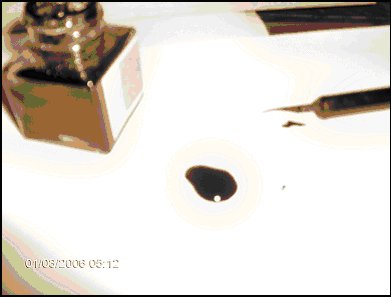 Figure 22 the classic ink blob on a page of writing paper |
||
| Dipping the metal nib inserted into the wooden pen handle; drawing up sufficient ink to be able to write, but without it being too much so that it would drip; according to Maestro Verna all this was facilitated by the threat of a whipping. | |
 Figure 23 an ink-filled“ buccett”(bottle) |
 Figure 24 “la pen nchi lu pinnine” (dilalect) that often had to be carried from home the pen with its nib |
|
Needless to say the dictations were full of mistakes which the teachers
attributed solely to the bestiality of the pupils, who, (according to them)
certainly were attending school due to a huge error of evaluation: they did not
have the right sort of brain. Addition, subtraction, division and small problems were an integral part of the teaching programme, but they became tragedies (for the pupils) because the teachers never even dreamed remotely of linking the bureaucratic problems of the State Scholastic Programme to the daily realities of those unfortunate children: it never even remotely passed through those teachers’ brains that weights and measures in the decimal metric system could be made understandable by referring to the measures of the ex-Kindom of the Two Sicilies already then in existence |
|
 Figure 25 c’era l’ossessione delle macchie vissute come cause di frustate |
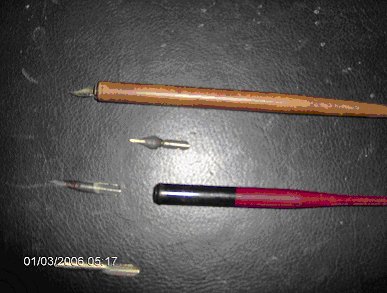 Figure 26 pens and nibs disassembled (nibs often had to be changed because they became blunt) |
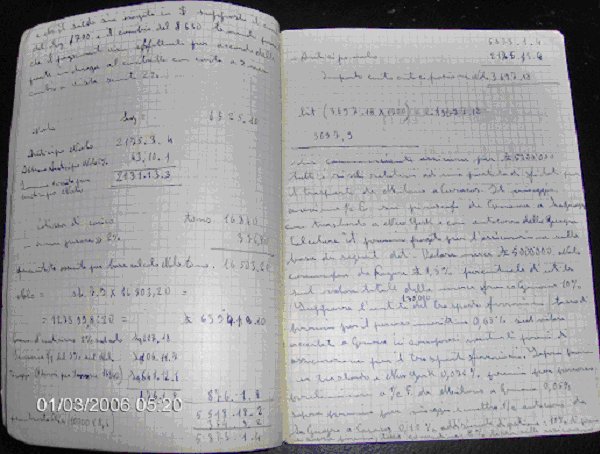 Figure 27 (writing in an exercise book using pen, nib and ink) |
|
|
Derision was increased by involuntary use of dialect, errors in dictation,
accents of dialect in reading, that rough idiom, born of so many mothers. Whippings were increased according to an unwritten dictum of Maestro Verna’s (he must have seen them, fixed to the walls in Papal Rome) (see the photos, Figures 21 and 21a, above) In any case the greatest numbers of whippings were given in order as follows: • extremely often to labourers sons; • very often to children of direct peasant growers who lived in the countryside; • often for children of direct peasant growers especially those not resident in Torricella; • sometimes for children of direct peasant growers living in Torricella; • occasionally for children of craftsmen of Torricella; • rarely for children of well-off merchants • almost never for children of other Professionals; • never for children of powerful patriots. I was classified as son of other Professionals and during the year I only received one whipping (my rank derived from having two maternal Aunts who were Elementary School Teachers, even though they held different political ideas to those of the Fascist Verna). In other words I can state that the person to be whipped was identifiable by what today would be defined as “census”[20] rather than for the gravity of the misdemeanour for which he was being reprimanded. |
 Figure 28 slightly dog-eared exercise books |
||
 Figure 29 another pen with nib ready for use; the nib was often detached and kept separately to aviod it getting broken by a knock |
||
 Figure 30 a pair of bakelite inkwells |
|
MY WHIPPING It was Christmas 1946 and the teacher had written a little greetings card on the blackboard which we pupils were supposed to copy onto a page in our exercise books to take to our parents. There was a fixed rule of iron in force from Verna, that if we should make a mistake, instead of making a mess, we had to underline the incorrect word and rewrite the exact one. Since I was living with my grandparents, my card was to be addressed to them. Obviously the Teacher had not written the name for the signature on the blackboard, since each one of us had to write our own name. Since my name is Giosia, I wrote Giosia, but then the teacher explained that the name should not be our official one, but rather the one which our parents usually called us at home (for example “Mingo” instead of Domenico, Cola instead of Nicola, Ricuccio instead of Enrico, etc.) With that explanation, following the above-mentioned rule, I underlined Giosia and wrote Peppino. When the Teacher read my card he became infuriated and when I tried with subdued words to justify myself because I had followed the rule for making a correction, he screamed at me “hold out that right hand which has committed this unforgivable error”. I held out my hand and with all his strength he beat the palm of my right hand whilst all my companions were laughing because finally they had got to see me being whipped too. |
|
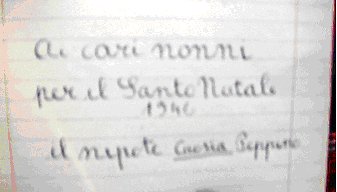 Figure 31 facsimile of the mistake which cost me a whipping |
 |
| Nevertheless that year I made a lot of progress with reading and writing because some friends of “Zi Ricuccio’s” daughters had had some recently published adult comics bought for them: GRAND HOTEL[21], which used comic strips to tell heart-rending love stories with happy endings, in which the baddies died and in the good guys lived happily and contentedly. The single copy was read in secret by many children, it was a forbidden magazine, but in the end, even though months later and in a furtive manner, it even came to me (my pleasant task was to read it to people who did not know how to read).) |
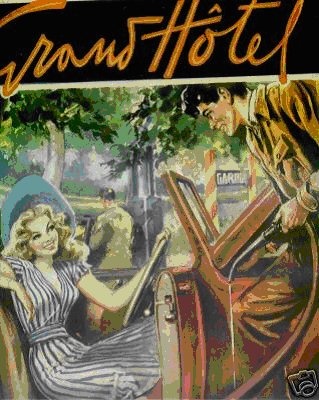 Figure 32 cover of an issue of the periodical magazine “Grand Hotel” |
|
That year I also made progress with studying
other problems.
Figure 33 (left) Giosia Aspromonte and (right) Donato Aspromonte in America They met in July 1990 in Santa Cruz, California, USA. PIECES OF PAPER ISSUED BY THE SCHOOL
So that is what the Second Elementary Class at
Torricella was like in 1946; it ought to have aimed at teaching one or more
disciplines by means of methodical, organised instruction. |
|
FOOTNOTES: [1] Examples of emigrée’s letters
|
|
[5] L Tirriete – means the
terraces or the terrace – in Torricella it is a large balcony or terrace, with a
wrought iron railing that faces the Church of San Giacomo Apostolo towards the
Corso. In this photo it is that balcony high up, behind the little girl. [6] Broomcorn – Broomcorn
(Sorghum bicolour variety technicum (Körnicke) Stapf ex Holland) is a utility
plant, not eaten but useful to humanity. Broomcorn probably derived from a sweet
sorghum (variety saccharatum grown for syrups and molasses) somewhere within the
north-eastern quadrant of Africa. Sometime during the Middle Ages, people along
the Mediterranean began cultivating the plant for its unique, long branched
panicle or seedhead, commonly called a brush.
According to the Alternative Field Crops Manual
(1990), broomcorn has three sub-varieties: standard which grows 6 to 15 feet
tall and produces a panicle 16 to 36 inches long, Western dwarf which
grows 4 to 7 feet, also producing long panicles, and whisk dwarf that
only grows 2.5 to 4 feet and produces 12 to 18 inch panicles with finer
bristles. Various panicle types are used together to make brooms for different
uses--home, outdoor, and industrial. ("Broomcorn", P.R. Carter, D.R. Hicks,
A.R. Kaminski, J.D. Doll, K.A. Kelling, G.L. Worf, University of Wisconsin and
University of Minnesota, 1990)
|
|||||||
|
In the United States
during World War II, due to its hardness and durability and due to copper being
needed for shell casings Bakelite was considered as a material for making
pennies. Several patterns were made in 1942, but steel was used instead in 1943
and recycled shell casings in 1944 and 1945. Bakelite Corp. was formed in 1922 and Bakelite Limited was formed in 1927; a new factory opened in Tyseley, Birmingham in 1931, which was in use until finally demolished in 1998. Phenolics are little used in general consumer products today due to the cost and complexity of production and their brittle nature. An exception to the overall decline is the use in small precision-shaped components where their specific properties are required, such as molded disc brake cylinders, saucepan handles, car-engine rotor arms, electrical plugs and switches, and parts for electrical irons. The retro appeal of old Bakelite products, especially kitchenware and toys, has made them quite collectable in recent years: A quick search, for example, of eBay, turns up hundreds of listings for all things Bakelite, ranging from radios to poker chips to telephones. [8] Alessandro Manzoni – 1785–1873, Italian novelist and poet, best known for his romantic novel The Betrothed “I promessi sposi” (1825–1827), considered one of the greatest works of modern Italian fiction. (In this novel, the young man complains about the mumbo-jumbo in Latin, used by the priest, which the hero calls “latinorum”). Manzoni wrote it under the influence of Sir Walter Scott; it was a novel of 16th-century Milan that reveals a detailed understanding of Italian life and remains one of Italy's most enduring novels. By 1875, 118 editions had appeared, and the work was widely translated. After its first issue, however, Manzoni continued to revise the work, publishing a stylistically superior version in Tuscan Italian in 1840. As a result, his influence on the development of a consistent Italian prose style was immense. latinorum – Latin, when used in a pedantic and deliberately incomprehensible manner (mumbo-jumbo): the quote from Manzoni says “che vuol ch’io faccia del suo latinorum?” “What do you want me to do with his latinorum?” (Manzoni) [9] Obligatory Military Service - in Italy it was not abolished until very recently. The law of 23 August 2004 suspended it - and it was no longer obligatory in Italy as from 1st January 2005. In the UK compulsory Military Service ended in the early 1960’s. (The year I (your translator) entered the University of London, 1961, was the first time that boys could go there straight from school and all the Professors commented on how young the students were by comparison with the previous years.) [10] “al giogo” – a relationship of servitude, dependency, being “in service” [11] National Fascist Party - (Partito Nazionale Fascista; PNF) was an Italian party, created by Benito Mussolini as the political expression of Fascism (previously represented by groups known as Fasci). Founded in Rome on November 7, 1921, it marked the transformation of the paramilitary Fasci Italiani di Combattimento into a more coherent political group (the Fasci di Combattimento had been founded by Mussolini in Milan's Piazza San Sepolcro, on March 23, 1919). The PNF was instrumental in directing and popularizing support for Mussolini's ideology. After the drastic modification of electoral legislation (the Acerbo Law), the PNF clearly won the highly controversial elections of April 1924. Law passed in 1928 made it the only legal party of the country, a situation which lasted until 1943. The party was dissolved upon the arrest of Mussolini after the coup inside the Grand Fascist Council, led by Dino Grandi on July 24, 1943; the Fascist Party was officially banned by Pietro Badoglio's government three days later. It is currently the only party whose re-formation is explicitly banned by the Constitution of Italy. [12] “tratti di corda” – the person being punished had their hands tied behind their back; another rope was tied to the hands that reached high up and was passed through a pulley that was high above the head of the person being punished; the end of the rope came down again into the hands of the hangman (executioner); he pulled down on the rope thus pulling the victim upwards to a certain height and then suddenly he would let go of the rope, so that the unfortunate victim would crash down to the ground. The torment was created by having the hands tied tightly behind the back, by the pulling backwards of the arms and by the fall to the ground. This so-called “tratti di corda” could be given several times with a minimum of three times for an adult man. Needless to say this punishment could cause the death of the person being punished. [13] Galileo Galilei - was an Italian scientist who formulated the basic law of falling bodies, which he verified by careful measurements. He constructed a telescope with which he studied lunar craters and discovered four moons revolving around Jupiter; he espoused the Copernican cause. Galileo Galilei was born on February 15, 1564 in Pisa, Italy. He pioneered the “experimental scientific method” and was the first to use a refracting telescope to make important astronomical discoveries. He discovered the moons of Jupiter and the phases of the planet Venus (similar to those of Earth's moon). As a professor of astronomy at University of Pisa, Galileo was required to teach the accepted theory of his time - that the sun and all the planets revolved around the Earth. Later at the University of Padua he was exposed to a new theory, proposed by Nicolaus Copernicus, that the Earth and all the other planets revolved around the Sun. Galileo's observations with his new telescope convinced him of the truth of Copernicus's sun-centered, or heliocentric, theory. Galileo's support for the heliocentric theory got him into trouble with the Roman Catholic Church. Because of his writings in Dialogue Concerning the Two Chief World Systems, Galileo was ordered to stand trial on suspicion of heresy. In 1633 the Inquisition convicted him of heresy; the sentence of the Inquisition was in three essential parts:
[17] Giovanni della Casa (28 June
1503 - 14 November 1556) was an Italian poet and writer.
[19] Kingdom of the Two Sicilies
- Southern Italy and the island of Sicily - was the new name that the Bourbon
King Ferdinand IV of Naples bestowed upon his domain after the end of the
Napoleonic Era and the full restoration of his power in 1816. The capital city
of the kingdom was Naples.
The Stock Whip is the classic
Australian whip, usually made from Kangaroo leather. The name comes from the
handle of the whip which is called the stock. and not from the fact that they
were used to control stock or cattle. |